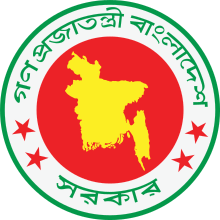Khulna
Khulna (Bengali: খুলনা [ˈkʰulna]) is the third-largest city in Bangladesh.[3] It is the administrative seat of Khulna District and Khulna Division. In the 2011 census, the city had a population of 663,342.[4] The Khulna metropolitan area had an estimated population of 1.022 million in 2014.[5]
Khulna খুলনা | |
|---|---|
     From top: Khulna Skyline, Gollamari Martyrs’ Memorial , Khan Jahan Ali Bridge , Khulna University, Khulna Medical College, Khulna Nagar Bhaban | |
 Khulna 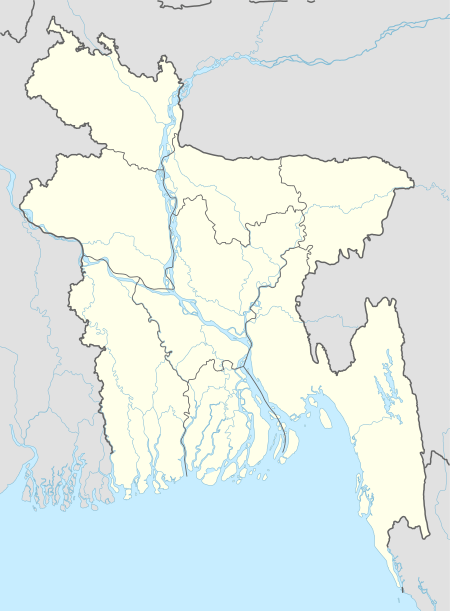 Khulna | |
| Coordinates: 22°49′N 89°33′E | |
| Country | |
| Division | Khulna Division |
| District | Khulna District |
| Municipal Council: | 12 December 1884 |
| Municipal Corporation: | 12 December 1984 |
| City Corporation: | 6 August 1990 |
| Government | |
| • Type | City Corporation |
| • Body | Khulna City Corporation |
| • Mayor | Talukder Abdul Khaleque |
| Area | |
| • Metropolis | 59.57 km2 (23.00 sq mi) |
| Elevation | 9 m (30 ft) |
| Population (2020) | |
| • Metropolis | 2,001,000 |
| • Density | 34,000/km2 (87,000/sq mi) |
| • Metro | 25,22,000 |
| Demonym(s) | Khulnaiya |
| Time zone | UTC+6 (BST) |
| Postal Code | Khulna GPO 9000 & Khulna Head Office 9100 |
| IDD : Calling Code | +880 (0)41 |
| Languages | Standard Bengali(Official) |
| Police | Khulna Metropolitan Police |
| Airport | Khan Jahan Ali Airport |
| Literacy rate | 89.1%[2] |
| Website | khulnacity |
Khulna is a port on the Rupsha and Bhairab Rivers. A hub of Bangladeshi industry, it hosts many national companies. Khulna is served by Port of Mongla (the second-largest seaport in the country), and is one of the two principal naval-command centres of the Bangladesh Navy. The navy base BNS Titumir is in the city.
A colonial steamboat service, including the Tern, Osrich and Lepcha, continues to operate on the river route to the city. Khulna is considered the gateway to the Sundarbans, the world's largest mangrove forest and home of the Bengal tiger. It is north of the Mosque City of Bagerhat, a UNESCO World Heritage Site.[6][7]
History
Khulna was part of the ancient kingdoms of Vanga or Samatata. It became part of the Sena dynasty during the 12th-century reign of Ballala Sena, and formed part of the Bagri division of Bengal. The region's previous name was Jalalabad.
During the 14th century, Shamsuddin Firoz Shah was the first Muslim ruler to arrive in the city; Muslim settlements increased during the time of Shamsuddin Ilyas Shah, and many mosques and shrines were established. A Muslim saint, Khan Jahan Ali, acquired a jagir (fiefdom) with a large portion of the Khulna Division from the king of Gauḍa during the 15th century. Ali exercised the full rights of sovereignty until his death in 1459.[8]
After Ali's death, the city again became part of the Sultanate of Bengal. During the reign of Daud Khan Karrani in the 16th century, Vikramaditya (one of Karrani's chief ministers) obtained a grant in southern Bengal—including Khulna—when Karrani was fighting the Mughals. Vikramaditya established a sovereign kingdom with its capital at Iswaripur (currently in Jessore District). He was succeeded by his son, Pratapaditya, who gained preeminence over the Baro-Bhuyans and controlled southern Bengal. Vikramaditya was defeated by Man Singh I, a Hindu general of the Mughal emperor Akbar, in 1611.[9]
Khulna remained under the rule of autonomous nawabs (rulers) of Bengal until 1793, when the British East India Company abolished nizamat (local rule) and took control of the city. The city became part of Jessore District in 1842, and became the headquarters of Khulna District (the Khulna and Bagerhat subdivisions of Jessore district, the Satkhira subdivision of 24 Parganas district, and the Sundarbans) in 1882.[9] Khulna had a pouroshava (municipal council) in 1884, which became a municipal corporation in 1984.
Before 19 August 1947, Khulna district was part of undivided Bengal. Khulna was first declared part of India in 1947, and the Indian flag was flown on 15 August. Syed Mohammad Abdul Halim an official of then Bengal civil service wrote the memorandum and send it to the boundary commission to include Khulna in Pakistan, the boundary commission declared Khulna under the east Bengal province.Sher e Bangla A.K.Fazlul Haq, Hamidul Haq Chowdhur, Muslim League leaders Khan A.Sabue, Abdul Mojid Khan, Advocate Hamidul Haq Chowdhury also involved in this process.The Pakistan government awarded later syed md Abdul Halim as TQA for this but he rejected the title in support of the 1971 war. He returned to his native village Bonomalidia, Faridpur. He died in September 1999 and was buried Banani graveyard.
_%E0%A6%AA%E0%A6%B0%E0%A6%BF%E0%A6%95%E0%A6%B2%E0%A7%8D%E0%A6%AA%E0%A6%A8%E0%A6%BE.png)
During the Bangladesh Liberation War, Pakistan Army created 314th ad hoc brigade to hold on to Khulna.[10] Pakistan Army's 93,000 troops unconditionally surrendered to the Indian Army and India's local ally Mukti Bahini on 16 December 1971.[11] This day and event is commemorated as the Bijoy Dibos (Bengali: বিজয় দিবস) in Bangladesh and Vijay Diwas in India.[12][11]
Geography
Khulna is Bangladesh's third-largest city, after Dhaka and Chittagong. In the south-western part of the country, on the Rupsha and Bhairab Rivers, it covers an area of 59.57 square kilometres (23.00 sq mi);[13] the district covers 4,394.46 square kilometres (1,696.71 sq mi). Khulna is south of Jessore and Narail, east of Satkhira, west of Bagerhat and north of the Bay of Bengal. It is part of the Ganges Delta, the world's largest river delta. The Sundarban, the world's largest mangrove forest, is in the southern part of the delta. Khulna is in the northern part of the district, and the Mayur River is the western boundary of the metropolitan area.
Climate
The city is humid during summer and pleasant in winter. Khulna has an annual average temperature of 26.3 °C (79.3 °F), with monthly average temperatures from 12.4 °C (54.3 °F) in January to 34.3 °C (93.7 °F) in May. Its annual average rainfall is 1,809.4 millimetres (71.24 in), and about 87 percent falls between May and October.
| Climate data for Khulna | |||||||||||||
|---|---|---|---|---|---|---|---|---|---|---|---|---|---|
| Month | Jan | Feb | Mar | Apr | May | Jun | Jul | Aug | Sep | Oct | Nov | Dec | Year |
| Average high °C (°F) | 25.6 (78.1) |
28.5 (83.3) |
33.1 (91.6) |
34.6 (94.3) |
34.3 (93.7) |
32.9 (91.2) |
31.8 (89.2) |
31.8 (89.2) |
32.1 (89.8) |
32.1 (89.8) |
29.9 (85.8) |
26.5 (79.7) |
31.1 (88.0) |
| Average low °C (°F) | 12.4 (54.3) |
15.4 (59.7) |
20.5 (68.9) |
23.9 (75.0) |
25.2 (77.4) |
26.1 (79.0) |
26.0 (78.8) |
26.2 (79.2) |
25.8 (78.4) |
24.1 (75.4) |
19.6 (67.3) |
13.9 (57.0) |
21.6 (70.9) |
| Average precipitation mm (inches) | 13.3 (0.52) |
44.4 (1.75) |
52.1 (2.05) |
87.5 (3.44) |
200.0 (7.87) |
335.6 (13.21) |
329.8 (12.98) |
323.5 (12.74) |
254.7 (10.03) |
129.8 (5.11) |
32.1 (1.26) |
6.6 (0.26) |
1,809.4 (71.24) |
| Average precipitation days | 2 | 3 | 3 | 6 | 11 | 14 | 17 | 16 | 13 | 7 | 2 | 1 | 95 |
| Average relative humidity (%) | 78 | 74 | 73 | 76 | 79 | 85 | 87 | 86 | 87 | 84 | 80 | 79 | 81 |
| Source: Bangladesh Meteorological Department[14][15][16][17][18] | |||||||||||||
Administration
Khulna Municipal Council was founded on 12 December 1884, and became a municipal corporation in 1984 and a city corporation in 1990. Khulna City Corporation is a self-governing corporation run by an elected mayor, who governs the city's 31 wards.
Khulna Metropolitan Police (KMP) maintains law and order and regulates traffic flow in the metropolitan area. It has eight police stations: Khulna Kotwali Thana, Sonadanga Thana, Khalishpur Thana, Daulatpur Thana, Khan Jahan Ali Thana, Aarongghata Thana, Horintana Thana and Labonchora Thana. The Metropolitan Magistrate Court (CMM) adjudicates the city's legal issues. The Khulna Development Authority (KDA) plans and coordinates the city's development. Khulna Water Supply & Sewerage Authority (KWASA) parallels the KCC.
Khulna has two parliamentary constituencies: Khulna-02 (Khulna Sadar Thana and Sonadanga Thana) and Khulna-03 (Khalishpur Thana, Daulatpur Thana and part of Khan Jahan Ali Thana). Khulna District and Khulna Division are headquartered in the city.
Demographics
In the 2011 census, Khulna had a population of 663,342.[4] The city and its metropolitan area had an estimated 2014 population of 1.022 million.[5] Its population density is about 19,000 inhabitants per square kilometre (49,000/sq mi). The city's literacy rate is 59.1 percent, higher than the national average of 56.5 percent.
Most of Khulna's population is Bengali, like the rest of Bangladesh. Residents of the city are known as Khulnaiya. Its population is also composed of people from neighbouring districts and from Barisal and Faridpur Divisions. Many people from Noakhali District live in the city, which also has a Bihari population.
Most residents of Khulna speak Bengali (the national language, its dialects and regional languages. English is understood by a large segment of the population, especially for business. There is a minority Urdu-speaking population, descendants of Muslims displaced from eastern India in 1947 who sought refuge in East Bengal.
Islam is Khulna's major religion, followed by 80.12 percent of the population. Other religions are Hinduism (19.11 percent), Christianity (0.67 percent) and Buddhism (0.04 percent).
Economy
Khulna is Bangladesh's third-largest economic centre. North of the Port of Mongla, it has a variety of light and heavy industry. Major sectors are jute, chemicals, fish and seafood packaging, food processing, sugar milling, power generation and shipbuilding. The KCCI regulates commerce through its Licensed Measurers’ Department (LMD) and certification, attestation and publicity departments of this area. The region has an Export Processing Zone, which has attracted foreign investment. The city is home to branch offices of a number of national companies, including M. M. Ispahani Limited, BEXIMCO, James Finlay Bangladesh, Summit Power and the Abul Khair Group. The largest companies based in the city include Khulna Shipyard, Bangladesh Cable Shilpa Limited, Bangladesh Oxygen, Platinum Jubilee Mills, Star Jute Mills and the Khulna Oxygen Company.
Transport
Road
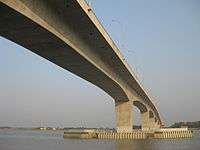
Rickshaws are the most popular means of public transport in Khulna for short trips, and auto rickshaws are also common. Nagar Paribahan buses have frequent service between Rupsha and Phultala, with stops throughout Khulna. Motorcycles are popular among the middle class, and wealthier people prefer a private car.
The N7 highway connects Khulna with the rest of Bangladesh, and the Khulna City Bypass is a major road. The R760 connects Satkhira and western Khulna Districts. There are several nationwide bus services available in Khulna (most privately owned), and the Bangladesh Road Transport Corporation operates inter-district bus service from the city. Sonadanga Bus Terminal is Khulna's main bus terminal. Major bus routes include Khulna-Jessore-Dhaka; Khulna-Goplaganj-Dhaka; Khulna-Jessore-Kushtia; Khulna-Satkhira; Khulna-Bagerhat; Khulna-Mongla; Khulna-Narail; Khulna-Barisal; Khulna-Rajshahi; Khulna-Faridpur; Khulna-Kuakata, and Khulna-Dhaka-Chittagong.
Rail

Khulna railway station is the city's main station in the city. Bangladesh Railway operates six intercity trains: the Sundarban and Chitra Express (to Dhaka), the Kapotaksha and Sagardari Express (to Rajshahi), and the Rupsa and Seemanta Express to Syedpur. Two commuter express trains serve Benapole, in addition to mail trains to Parbatipur, Chapainawabganj and Goalanda. The international Bandhan Express runs to Kolkata. There are four other railway stations in Khulna, and two more (in addition to the Rupsha Rail Bridge) are under construction as part of the Khulna–Mongla Port Railway project.
Air
Khan Jahan Ali Airport is under construction. Jessore Airport, 71 kilometres (44 mi) north of the city centre, is the region's only airport. Biman Bangladesh Airlines, United Airways, US-Bangla Airlines and Novoair have regular flights between Jessore and Dhaka, with air-conditioned bus service from the airport to Khulna.
Water
Several passenger launches and cargo services operate from the Bangladesh Inland Water Transport Authority Launch Terminal in Khulna, with express service to Dhaka.
Education

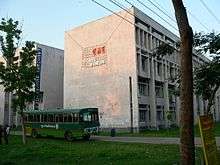

Khulna has a number of educational institutions. The most prestigious institute in Khulna is Khulna University of Engineering & Technology (KUET). The Khulna University of Engineering & Technology (KUET) is the only engineering university in Khulna, has been ranked in the 2019 edition of QS Asian University Rankings. The QS authority has mentioned that KUET has a sober objective to achieve excellence in quality education, research and progression to address the present needs of the country as well as the South-Western region to make it as the "Center of Excellence". Moreover, top graded students of the country are enrolled yearly at the undergraduate level through very competitive, transparent and standard admission tests.[20] Brajalal College, founded in 1902, is the city's oldest higher-education institution. It also has a general public university, named Khulna University which is the only public university in Bangladesh where student politics is prohibited..There is also an agriculture university, named Khulna Agricultural University (KAU) which had its first batch in 2018. The Khulna Medical College (KMC) and BL College are also in the city. North Western University, Bangladesh (NWU) and the Northern University of Business and Technology (NUBT) are private institutions.
Colleges
- Shahid Suhrawardy College Khulna
- Azam Khan Government Commerce College
- BN English School and College
- BN School and College, Khulna
- Cantonment Public College
- Daulatpur College (Day/Night)
- Bangabandhu College
- Hazi Md Muhasin College
- Government Majid Memorial City College
- Govt. Pioneer Women's College
- Govt. Sundarban College
- Islamabad Collegiate School Khulna (ICSK)
- Islamia College
- KCC Women's College
- Ahshanullah College
- Khulna Govt. Women's College
- Khulna Public College
- Military Collegiate School Khulna (MCSK)
- Chuknagar Degree College
- Mohshin College
- Rayermohal (Honours) College, Khulna Sadar
- Shahpur Madhugram College, Shahpur, Khulna
- South East Engineering College
- Govt. B.L College Daulatpur, Khulna
Polytechnic institutes
- City Polytechnic Institute Khulna (private)
- Desh Polytechnic Institute (private)
- Hope Polytechnic Institute (private)
- Islami Bank Polytechnic Institute (private)
- Khan Jahan Ali Polytechnic Institute (private)
- Khulna Mohila Polytechnic Institute
- Khulna Polytechnic Institute
- Khulna Technical Institute (private)
- Mangrove Polytechnic Institute of Science and Technology (private)
- North South Polytechnic Institute (private)
- Sundarban Polytechnic Institute (private)
Healthcare
Hospitals
- Khulna Medical College Hospital
- Shaheed Sheikh Abu Naser Specialized Hospital
- Nargis Memorial Hospital
- Khulna City Medical College Hospital
- Islami Bank Hospital
Sports
Cricket and football are the two most popular sports in Khulna, and the Khulna Division cricket team has its home ground in the city. Khulna's Bangladesh Premier League Khulna Titans were formerly the Khulna Royal Bengals. The Khulna Abahani Club played in Bangladesh Football Premier League for several seasons before its relegation in the 2008–09 Bangladesh Premier League season.
Sheikh Abu Naser Stadium, the city's only international sports venue (hosting test cricket, One Day International and Twenty20 International matches), became Bangladesh's seventh test-cricket venue on 21 November 2012; it also hosts several Bangladesh Premier League matches.[21] Khulna District Stadium hosts other domestic sports and cultural events.
Media
Newspapers include the Daily Purbanchal, Daily Janmabhumi, Daily Shomoyer Khobor, Daily Probah, Dakhinanchal Protidin and the English-language Daily Tribune. Khulnainfo.com is a web portal.[22] Radio Stations are Bangladesh Betar Khulna (106.5 MHz) Radio Today (89.6), Radio Foorti (88.0), and Radio Khulna FM (88.8).
Tourism
The Sundarbans, in Khulna District, is home to the Bengal tiger and the world's largest virgin mangrove forest). It is a UNESCO World Heritage Site.[23]
The Mosque City of Bagerhat is a formerly-lost city in the suburbs of Bagerhat, about 15 miles (24 km) south-est of Khulna. It is also a World Heritage Site.[24]
Rabindra Complex is in the village of Dakkhindihi, 19 kilometres (12 mi) from Khulna. The home of Rabindranath Tagore's father-in-law, Beni Madhab Roy Chowdhury, Tagore visited it several times. The museum has been renovated and is administered by Bangladesh's Department of Archaeology.[25]
The Khulna Divisional Museum, founded in 1998, is the city's only museum. It was established by Bangladesh's Department of Archaeology.
Notable People from Khulna
- Sheikh Razzak Ali – Lawyer, politician, deputy speaker and speaker of the Jatiyo Sangsad
- Abdus Sabur Khan – Politician
- Tanvir Mokammel – Filmmaker and writer
- Firoz Mahmud- Visual artist and painter
- Khan Jahan Ali – Sufi saint
- Prafulla Chandra Ray – Chemist
- Prafulla Chandra Sen – Former West Bengal chief minister
- Sheikh Abu Naser – Politician
- Qazi Imdadul Haq – Writer
- Nilima Ibrahim- Educator, intellectual and social worker
- Sheikh Salahuddin – Former cricketer
- Manjural Islam Rana- Cricketer
- Bishnu Chattopadhyay – Freedom fighter and peasant leader
- Abdur Razzak – Bangladesh national cricket team member
- Manjural Islam Rana – Bangladesh national cricket team member
- Popy (Sadia Parvin Popy) – Actress, model
- Moushumi (Arifa Pervin Moushumi) – Actress, model
- Salma Khatun – Cricketer
- Jahanara Alam – Cricketer
- Rumana Ahmed – Cricketer
- Mehedi Hasan – Cricketer
- Puja Cherry Roy – Actress
- Afif Hossain – Cricketer
- Nurul Hasan Sohan – Cricketer
- Ayasha Rahman – Cricketer
- Shukhtara Rahman – Cricketer
- Tahin Tahera – Cricketer
- Shaila Sharmin – Cricketer
- Md. Rafiqul Islam - Editor/ Secretary General: Parliament Watch
- Ziaur Rahman – Cricketer
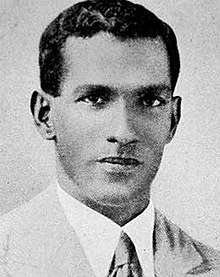 Prafulla Chandra Ray
Prafulla Chandra Ray Sheikh Razzak Ali meeting with Queen Elizabeth II
Sheikh Razzak Ali meeting with Queen Elizabeth II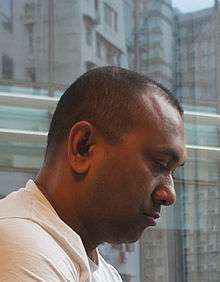 Firoz Mahmud
Firoz Mahmud Tanvir Mokammel
Tanvir Mokammel
References
- "Area, Population and Literacy Rate by Paurashava −2001" (PDF). Bangladesh Bureau of Statistics. 2001. Archived from the original (PDF) on 25 June 2008. Retrieved 19 August 2009.
- Tapan Palit (2012). "Khulna City Corporation". In Sirajul Islam and Ahmed A. Jamal (ed.). Banglapedia: National Encyclopedia of Bangladesh (Second ed.). Asiatic Society of Bangladesh.
- "Bangladesh–10 Largest Cities". Archived from the original on 13 February 2019. Retrieved 10 September 2019.
- "Population & Housing Census-2011" (PDF). Bangladesh Bureau of Statistics. p. 44. Archived from the original (PDF) on 8 December 2015. Retrieved 15 December 2015.
- "World Urbanization Prospects, 2014 Revision" (PDF). United Nations. p. 319. Archived from the original (PDF) on 22 January 2019. Retrieved 6 December 2017.
- Marshall Cavendish Corporation (2007). World and Its Peoples: Eastern and Southern Asia. Marshall Cavendish. p. 491. ISBN 9780761476313.
- Girard, Luigi Fusco (2003). The Human Sustainable City: Challenges and Perspectives from the Habitat Agenda. Ashgate Publishing, Ltd. p. 298. ISBN 9780754609452.
- "জেলার ঐতিহ্য". Khulna District Portal. Archived from the original on 13 December 2013. Retrieved 21 December 2013.
- Hunter, William Wilson (1908). Imperial Gazetteer of India. Oxford, UK: Oxford University Press. p. 287.
- Salik, Siddiq, Witness to Surrender, pp126
- Team, Editorial (17 December 2017). "Why Do India Celebrate 'Vijay Diwas' On 16th December". SSBToSuccess. Retrieved 18 December 2017.
- "About us". Liberation War Museum. Archived from the original on 8 November 2011. Retrieved 21 November 2011.
- Bangladesh Bureau of Statistics; Area, Population and Literacy Rate by Paurashava – 2001 (pdf-file) Retrieved on 29 September 2008.
- "Monthly Maximum Temperature". Bangladesh Meteorological Department. Retrieved 31 January 2016.
- "Monthly Minimum Temperature". Bangladesh Meteorological Department. Retrieved 31 January 2016.
- "Normal Monthly Rainfall". Bangladesh Meteorological Department. Retrieved 31 January 2016.
- "Normal Monthly Rainy Day". Bangladesh Meteorological Department. Retrieved 31 January 2016.
- "Normal Monthly Humidity". Bangladesh Meteorological Department. Retrieved 31 January 2016.
- "About Khulna". Khula City Corporation.
- https://www.topuniversities.com/universities/khulna-university-engineering-technology
- "BPL 2013 to kick off on January 17". ESPN Cricinfo. 11 October 2012. Retrieved 31 October 2012.
- "Khulnainfo.com". Retrieved 13 September 2019.
- "The Sundarbans". World Heritage List. UNESCO. Retrieved 13 September 2019.
- "Historic Mosque City of Bagerhat". World Heritage List. UNESCO. Retrieved 13 September 2019.
- "Rabindra museum draws huge crowd". The Independent (Bangladesh). Retrieved 13 September 2019.
18. Zahidul Islam Sana, Lecturer, 🎓 University of Dhaka.
External links
| Wikimedia Commons has media related to Khulna. |
| Wikivoyage has a travel guide for Khulna. |
- Official Website of Khulna City Corporation
- Khulna District on Banglapedia
- Khulna Guide at Discovery Bangladesh
- Population and Housing Census 2011 - Volume 3: Urban Area Report (PDF), Bangladesh Bureau of Statistics, August 2014
